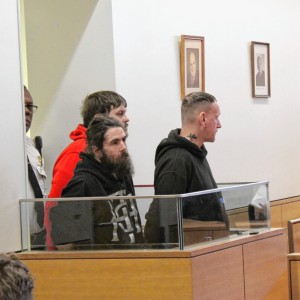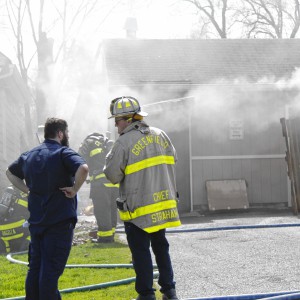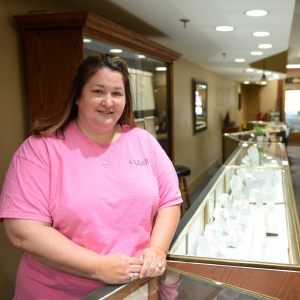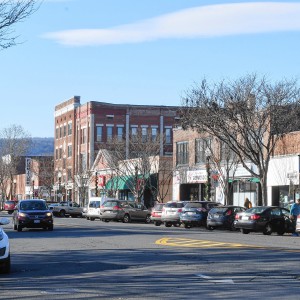Charlemont souvenir shop seeks input to redesign Indigenous statue
| Published: 01-25-2023 4:33 PM |
CHARLEMONT — After a discussion with the creators of a petition to remove the large Native American statue from the Native and Himalayan Views souvenir shop on Route 2, the owner is seeking community input on possible new designs for the landmark.
“Instead of destroying the thing, I want to change it and continue to make it a landmark but not have anyone be offended,” owner Sonam Lama said in an interview.
In October 2022, Tomantha Sylvester, a team member at the Ohketeau Cultural Center in Ashfield, created a petition calling to remove the statue, saying it perpetuates racist stereotypes. The petition, which can be viewed at bit.ly/3CtQ5Lr, garnered nearly 1,300 signatures and led to the start of a dialogue with Lama.
The statue stands taller than the gift shop building, formerly known as “The Big Indian Shop,” and features a feathered headdress (an ornamental covering that some western Indigenous nations wear, but that is not worn by eastern tribes). The statue’s “skin” is painted a deep red.
The statue was made by Rodman Shutt, a sculptor from Strasburg, Pennsylvania who made larger-than-life pieces across the Northeast in the 1960s and ‘70s. Shutt has several other sculptures of Indigenous people in Maine and New York. The Charlemont statue has stood at the gift shop since 1974.
Sylvester, fellow Ohketeau Cultural Center team member Rhonda Anderson and Laurel Davis-Delano, a professor of sociology at Springfield College who works to eliminate Indigenous mascots from sports teams, all spoke with Lama about the harmful stereotypes they feel are depicted at the souvenir shop.
“The caricature images found at Native and Himalayan Views continue to invisibilize hundreds of sovereign nations and cultures, and glorify the settler colonial action of westward expansion and manifest destiny as a way to dehumanize and erase Indigenous peoples,” Sylvester wrote in the petition. She added that western and central Massachusetts are full of historical inaccuracies, stereotypes and cultural appropriation, but she feels this statute is one of the “most egregious” offenses.
As a result of the discussions, Lama hopes to change the sculpture to one of three designs. The business has shared the sample designs on Facebook at bit.ly/3WAV1pW and is seeking feedback from the community.
Article continues after...
Yesterday's Most Read Articles
 New owners look to build on Thomas Memorial Golf & Country Club’s strengths
New owners look to build on Thomas Memorial Golf & Country Club’s strengths
 Orange man gets 12 to 14 years for child rape
Orange man gets 12 to 14 years for child rape
 Greenfield Police Logs: April 2 to April 8, 2024
Greenfield Police Logs: April 2 to April 8, 2024
 One Greenfield home invasion defendant up for bail, other three held
One Greenfield home invasion defendant up for bail, other three held
 Fire scorches garage on Homestead Avenue in Greenfield
Fire scorches garage on Homestead Avenue in Greenfield
 Cleary Jewelers plans to retain shop at former Wilson’s building until 2029
Cleary Jewelers plans to retain shop at former Wilson’s building until 2029
“We want to make sure everyone feels included,” Bob Pollock, Lama’s family friend who helps represent and translate for him, said about why they are sharing the possible designs with the public.
One of the three design options incorporates a sun mask, which looks like a sun complete with rays. Another design includes a mask with brightly colored fall leaves. The final design option is a traditional Himalayan sun mask, which is blue and includes facial features. Lama and his wife, who bought the shop in 2009 when the former owners retired, immigrated from Tibet and have chosen this design from their own culture.
When asked how Sylvester and Anderson felt about a discussion, they wrote in a group statement, “One of the biggest takeaways was the value of having a face-to-face conversation with each other and to begin building a relationship of understanding and trust.”
Of the potential designs and other changes, Sylvester and Anderson wrote, “We have secured enormous support for changes to the store from Indigenous peoples in Massachusetts, including Indigenous organizations, tribal citizens, tribal representatives and tribal nations.”
Also discussed was the souvenir shop’s violation of the Indian Arts and Crafts Act of 1990. The law prohibits misrepresenting the marketing of Indigenous art and craft products. Lama has since properly labeled the goods in the store that were made by people of Indigenous descent. The store also might be divided into different sections to further prevent confusion.
Pollock explained that most of the store’s sales revenue does not come from Indigenous crafts, which are more expensive, so the store plans to continue to sell crafts made by people from a variety of ethnic backgrounds.
Lama also plans to change the teepee, commonly associated with western Indigenous peoples, to a yurt.
“They didn’t mean to offend Native Americans. They have a shared identity being migrants, and a shared sense of oppression,” Pollock said of Lama and his wife. “They are coming from a good place.”
The store is also known as a photo opportunity for tourists traveling along Route 2, so Pollock noted that Lama does not want to completely remove the statue as doing so would likely reduce the appeal for potential shoppers.
“We hope that people in the community understand that representation matters,” Sylvester and Anderson wrote. “The store has only been around since 1954, and in the 1950s, racist depictions were rampant and acceptable. Indigenous peoples have been here for tens of thousands of years and are still here.”
Reach Bella Levavi at 413-930-4579 or blevavi@recorder.com.

 Greenfield City Council approves borrowing $1.18M for Main Street redesign, sewer repairs
Greenfield City Council approves borrowing $1.18M for Main Street redesign, sewer repairs Gun buyback event collects 195 unwanted firearms
Gun buyback event collects 195 unwanted firearms Quabbin region studied for MWRA expansion
Quabbin region studied for MWRA expansion
